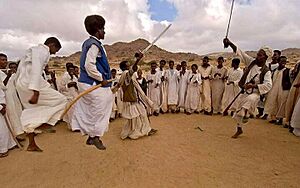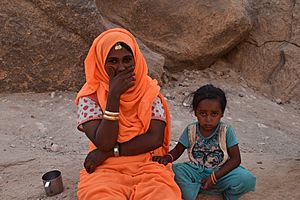Beja people facts for kids
| البجا | |
|---|---|

Beja men dancing
|
|
| Total population | |
| 1,900,000–2,759,000 | |
| Regions with significant populations | |
| Eastern Desert | |
| 2,620,000 (2024) | |
| 121,000 (2022) | |
| 88,000 (2023) | |
| Languages | |
| Arabic (Sudanese Arabic), Beja, Tigre | |
| Religion | |
| Sunni Islam | |
| Related ethnic groups | |
| Cushites, Tigre, Sudanese Arabs, Nubians | |
The Beja people (Arabic: البجا, Beja: Oobja, Tigre: በጃ) are a group of people who live in northeast Africa. They are from the Eastern Desert, a coastal area. This area stretches from southeastern Egypt through eastern Sudan to northwestern Eritrea.
The Beja people are descendants of groups who lived in this area since at least 4000 BC. Over time, they mixed with Arabs who moved into the region. Many Beja people are nomads, meaning they move from place to place. They mostly live in the Eastern Desert. There are about 1.9 million to 2.7 million Beja people today.
Some Beja people speak a language called Beja, which is a Cushitic language. Others speak Tigre. However, most Beja people speak Arabic. In Eritrea and southeastern Sudan, many of the Beni-Amer group speak Tigre.
The Beja people did not originally speak Arabic. But many Arab tribes moved into Beja areas. This led to the Beja people adopting the Arabic language and Islam. They also started to wear Arab clothing and organize their families like Arabs. The Beja people have mixed with Arabs through marriages over many centuries. By the 15th century, most Beja people had become Muslims.
Some people think the Ababda are an Arabic-speaking Beja tribe. This is because they share some cultural links with the Bishari. However, the Ababda do not see themselves as Beja, and Beja people do not consider them Beja either.
Beja History and Origins

The Beja people have a long history in northeast Africa. They are traditionally pastoral nomads, meaning they move with their animals. Ancient writings called them "Blemmyes". A geographer named Abu Nasr Mutahhar al-Maqdisi wrote in the 10th century that the Beja were Christians at that time.
In the 3rd century, the Kingdom of Aksum took control of Beja lands in the Eastern Desert. The historian Al-Yaqubi wrote about five Beja kingdoms in the 9th century. As Arab tribes moved into the area, the Beja people gradually adopted the Arabic language and the Islamic religion. This process was completed by the 15th century.
Some people believe the Balaw people, who live on the southern Red Sea coast, came from a mix of Arab and Beja people. By the 18th century, the Hadendoa Beja group became very powerful in eastern Sudan.
During the Mahdist War (1880s-1890s), some Beja groups fought alongside the Mahdist troops. Others, like the Bisharin and Amarar tribes, supported the British. Some Beni-Amer Beja, who mostly live in Eritrea, fought with the Ethiopian leader Ras Alula.

In 1952, the Beja Congress was formed. Its goal was to gain more control over their region from the government in Khartoum. Because they felt things were not changing fast enough, the Beja Congress joined a group called the National Democratic Alliance in the 1990s. The Beja Congress actually controlled part of eastern Sudan. They even damaged the oil pipeline to Port Sudan a few times in 1999 and 2000.
In 2003, they did not agree with a peace deal between the Sudanese government and another group. So, in January 2004, they joined forces with a rebel group from the Darfur region. A peace agreement was finally signed with the government of Sudan in October 2006. However, in the 2010 elections, the Beja Congress did not win any seats. They were upset about this and about the slow progress of the peace agreement. In October 2011, they left the agreement and announced a new alliance with the Sudan Liberation Movement/Army.
Where Do Beja People Live?
The Beja people live in an area called the Eastern Desert. This area is located between the Nile River and the Red Sea. It stretches across Sudan, Eritrea, and eastern Egypt.
Most Beja people live in Sudanese states like Red Sea (near Port Sudan), River Nile, Al Qadarif, and Kassala. They also live in parts of Eritrea, including the Northern Red Sea, Gash-Barka, and Anseba Regions. Smaller groups of Beja people live further north in Egypt's Eastern Desert. Some Beja groups are nomads, meaning they travel often.
A large number of Qamhat Bisharin Beja live in the Kharga Oasis in Egypt. They moved there after being displaced by the Aswan High Dam. The Jebel Uweinat mountain is a very important place for the Qamhat.
Different Names for the Beja
The Beja people have been called by different names throughout history. In Roman times, they were known as "Blemmyes". In ancient Aksumite writings, they were called "Bəga".
The British writer Rudyard Kipling called them "Fuzzy-Wuzzy". He was specifically talking about the Hadendoa group. The Hadendoa fought against the British, supporting the Mahdi. The Mahdi was a Sudanese leader who fought against Turkish-Egyptian rule, which was supported by the British.
Beja Languages
Many Beja people speak Arabic. However, some also speak the Beja language, which they call Bidhaawyeet or Tubdhaawi. This language is part of the Cushitic branch of the Afroasiatic language family. One expert, Cohen, noted that the Beja language has many words that come from Semitic languages, mostly Arabic.
A French linguist named Didier Morin suggested that Beja language might be linked to other Cushitic languages. These include Afar and Saho. This idea is based on the fact that these three languages were once spoken in areas close to each other.
Most Beja people speak the Beja language. But some groups use other languages. For example, the Beni Amers speak a type of Tigre. Most of the Halenga group speak Arabic.
Even though Arabic has influenced the Beja language, it is still widely spoken. The Beja language is important for their culture and values. Beja poetry is highly valued. Also, claims over Beja land are often only valid when spoken in Beja. These are strong reasons why the language is kept alive. Arabic is seen as the language of modern times. But the Beja language is still very important and respected in their community.
Beja Groups and Kingdoms
The Beja people are divided into different groups, or clans. These groups include the Bisharin, Hedareb, Hadendowa (or Hadendoa), and the Amarar (or Amar'ar). Other groups are the Beni-Amer, Hallenga, Habab, Belin, and Hamran. Some of these groups have mixed with Bedouin people in the east.
Historically, Beja society was made up of independent kingdoms. According to Al-Yaqubi, there were six Beja kingdoms in the 9th century. These kingdoms were located between Aswan and Massawa. Some of these kingdoms were the Kingdom of Bazin, Kingdom of Belgin, Kingdom of Jarin, Kingdom of Nagash, Kingdom of Qita'a, and Kingdom of Tankish.
|
See also
 In Spanish: Pueblo beja para niños
In Spanish: Pueblo beja para niños




